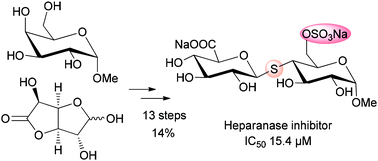Synthesis of novel S- and O-disaccharide analogs of heparan sulfate for heparanase inhibition†
Abstract
Heparan sulfate (HS), a glycosaminoglycan related to heparin, is a linear polysaccharide, consisting of repeating disaccharide units. This compound is involved in multiple biological processes such as inflammation, coagulation, angiogenesis and viral infections. Our work focuses on the synthesis of simple HS analogs for the study of structure–activity relationships, with the aim of modulating these biological activities. Thioglycoside analogs, in which the interglycosidic oxygen is replaced by a sulfur atom, are very interesting compounds in terms of therapeutic applications. Indeed, the thioglycosidic bond leads to an improvement of their stability and can allow the inhibition of enzymes involved in physiological and pathological processes. In our previous work, we developed a synthetic sequence which led to a non-sulfated thiodisaccharide analog of HS. In this paper, we report our results of the development of a new synthetic method allowing access to the novel sulfated S-disaccharide, as well as to their oxygenated analogues (O-disaccharide and sulfated O-disaccharide). These 4 compounds were also tested for the inhibition of heparanase, an enzyme involved in biological processes like tumor growth and inflammation. The obtained IC50 values in the micromolar range showed the impact of the interglycosidic sulfur atom and the 6-sulfate group.



 Please wait while we load your content...
Please wait while we load your content...